Foods That Improve Beta Cell Function: A Simple Guide to Better Health
Beta cells are tiny workers in your pancreas that play a big role in your body. Their job is to produce and release insulin, a hormone responsible for regulating your blood sugar levels. If beta cells don’t function properly, you may be at risk for diabetes or other metabolic problems. The good news? Certain foods can help improve beta cell function! Adding these foods to your diet can give your pancreas the support it needs. Let’s explore what they are and how they work.
Why Beta Cells Are Important
Before diving into the food options, let’s quickly review why beta cells are so essential. When you eat food, it gets broken down into glucose, which fuels your body. Beta cells release insulin to ensure glucose is absorbed into your cells, giving you energy. If beta cells become damaged or overworked, they may not release enough insulin. This leads to high blood sugar levels, which can result in health issues like diabetes.
Fortunately, science shows that certain foods can protect and even improve beta cell function. Foods rich in antioxidants, vitamins, healthy fats, and plant compounds are particularly helpful. Let’s explore these foods one by one.
1. Leafy Green Vegetables
Leafy greens like spinach, kale, and Swiss chard are bursting with antioxidants, which protect beta cells from damage caused by free radicals. Free radicals are unstable molecules that can harm your cells, leading to inflammation and oxidative stress. Beta cells are delicate, so they benefit from the protective effects of antioxidants.
Additionally, leafy greens are low in carbs and rich in magnesium, a mineral linked to better insulin function. Try adding a handful of spinach to smoothies, salads, or stir-fry dishes.
2. Nuts and Seeds
Nuts and seeds are packed with healthy fats, protein, and fiber, which help stabilize blood sugar levels. Walnuts, almonds, chia seeds, and flaxseeds are especially good choices. These foods contain omega-3 fatty acids, which reduce inflammation and support beta cell health.
For example, walnuts have been shown to improve insulin sensitivity, which makes it easier for beta cells to do their job. Sprinkle nuts or seeds over your yogurt, oatmeal, or salads for a crunchy, nutritious boost.
3. Blueberries and Other Berries
Blueberries, strawberries, and raspberries are not only delicious but also beta cell-friendly. These colorful fruits are rich in anthocyanins, a type of antioxidant that protects beta cells and improves insulin function.
Studies have found that blueberries can help enhance insulin sensitivity and reduce oxidative stress, making them a great choice for those looking to support their pancreatic health. Toss a handful of berries into your cereal or enjoy them as a snack.
4. Healthy Fats: Olive Oil and Avocados
Your beta cells love healthy fats, and olive oil and avocados are some of the best sources. These foods contain monounsaturated fats, which lower inflammation and support better insulin function.
Olive oil also has polyphenols, plant compounds that protect beta cells from oxidative stress. Use olive oil as your go-to for cooking or as a salad dressing. Similarly, enjoy avocados on toast, in salads, or blended into smoothies.
5. Whole Grains
Whole grains like oats, quinoa, and brown rice are much better for beta cells than refined grains like white bread or sugary cereals. Whole grains are high in fiber, which helps regulate blood sugar and reduce the workload on your beta cells.
Fiber also feeds the good bacteria in your gut, which play a role in reducing inflammation and supporting overall metabolic health. Replace white rice with quinoa or swap sugary cereals for oatmeal to give your beta cells a break.
6. Fatty Fish
Salmon, mackerel, sardines, and other fatty fish are rich in omega-3 fatty acids, which are known to fight inflammation. Chronic inflammation can damage beta cells, so eating fish helps protect them and keeps your insulin levels healthy.
If you’re not a fan of fish, you can also get omega-3s from algae-based supplements or other omega-rich foods like flaxseeds.
7. Cinnamon
Cinnamon isn’t just a tasty spice; it’s a superfood for beta cells. This fragrant seasoning has been shown to reduce blood sugar levels by enhancing insulin sensitivity. Cinnamon may also protect beta cells from damage caused by oxidative stress.
Sprinkle cinnamon on your oatmeal, tea, or smoothies for both flavor and health benefits. Just be mindful to use true cinnamon (Ceylon cinnamon), as it’s safer and more effective than the common cassia variety.
8. Beans and Lentils
Beans and lentils are excellent sources of fiber and plant-based protein. They help regulate blood sugar levels, which reduces the stress on beta cells. These legumes are also rich in magnesium, a mineral that improves insulin function.
Whether you prefer black beans, chickpeas, or lentils, these versatile ingredients can be added to soups, salads, and stir-fries. They’re affordable and incredibly nutritious.
Tips for a Beta Cell-Friendly Diet
- Avoid Sugar: High sugar intake can overwork your beta cells, leading to damage over time. Choose fresh fruits and whole grains over sugary snacks.
- Eat Balanced Meals: Pair proteins, fats, and fiber-rich carbohydrates to keep your blood sugar steady and reduce stress on beta cells.
- Stay Hydrated: Drinking enough water helps your body function smoothly and supports overall health.
Conclusion
The health of your beta cells is critical for preventing diabetes and maintaining balanced blood sugar levels. By incorporating the right foods into your diet—like leafy greens, nuts, berries, and fatty fish—you can protect these hardworking cells and improve their function.
Taking small yet consistent steps can lead to big improvements in your health. And the best part? These foods aren’t just good for your beta cells—they’re great for your overall well-being! Start adding them to your plate today, and support your body from the inside out.


